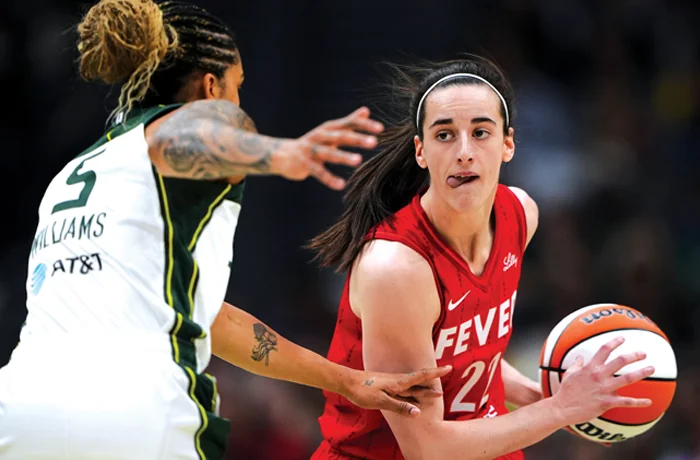You see it in the numbers. The fans voted her first for the All-Star Game with over 1 million votes. The players ranked her ninth among guards. Not second or third or even fifth — ninth. The 2024 No. 1 overall pick, rookie of the year, and All-WNBA player was ranked behind Brittney Sykes, Natasha Cloud, and a bunch of other players whose jerseys hardly fly off the shelves.
When you look at the raw numbers, maybe the players have a point. Clark has only played nine games this year, just over half the Indiana Fever’s schedule. First, it was a quadricep strain that kept her out for three weeks. Now it’s a groin injury. She’s shooting under 30% from 3-point range, which is terrible for someone who made her name launching shots from the parking lot. She leads the league in turnovers with almost six a game. That’s not great.
Even so, she’s certainly not bad. She’s still second in the league in assists. She’s still making almost three 3-pointers a game, even though she’s shooting them badly. But much more importantly than any of that, her celebrity is off the charts. And for the WNBA, ignoring and downplaying its biggest star’s stardom is both untenable from a business perspective and also simply not going to work at shaping the narrative. The people demand Caitlin Clark. Every arena she walks into draws more fans than when she leaves. Every game she plays gets better television ratings than any other game that week. The league is making money off her missed shots.

When it comes to the biggest stars, this kind of gap between how the fans and the fellow professionals feel isn’t how it usually works in sports. Barry Bonds was hated by fans and teammates alike. LeBron James is loved by nearly everyone involved with basketball. Tom Brady had the hearts of the fans in New England and later Tampa Bay, plus the teammates who would go anywhere to play with him. But Clark? She’s got the fans and nobody else.
For the WNBA, this is a rare opportunity, and the league needs to stop trying to walk a fine line around this and start outright selling it. If executives were smart, they would make Clark the whole show. They’d turn every game into Clark versus everybody. Get some loudmouth commentators to argue about it on television all night long. Put cameras on the other players when Clark hits another 3-pointer from 30 feet. Show their faces. Let people see the resentment.
The WNBA is a business that doesn’t make much money. Last year, the whole league brought in about $200 million. That’s for 12 teams. The Winnipeg Blue Bombers, the most popular team in the Canadian Football League, made $45 million by themselves. Few people in America know what the Blue Bombers are. But that regional favorite makes almost a quarter of what the entire WNBA makes. Sports betting is already the prime mover in keeping lesser sports like the WNBA on the air and, along with Clark’s marketability, the main reason the league landed an 11-year broadcasting deal that pays it about $200 million a year starting this season.
The fact is that women’s basketball is hard to watch if you’re used to the men’s game. The shooting percentages are lower. Almost nobody dunks. The games move slower. Todd Gallagher wrote a book in which he played one-on-one against a WNBA player when he was just a guy who played high school ball. He destroyed her because he was 9 inches taller and 60 pounds heavier. That’s the reality nobody wants to talk about.
But none of that matters if you can sell a story that papers over the deficiencies, and Clark is a story people want to buy. She shoots from distances that make coaches nervous. She passes like she’s got eyes in the back of her head. She plays with the kind of confidence that makes people mad. Many of the other players see it as arrogance, especially when A’ja Wilson is the unsung true star of the league and Angel Reese has her own branded McDonald’s Quarter Pounder and modeling gigs.
So the league keeps trying to protect everyone’s feelings because the reality it is sitting on of a single, world-bestriding star is not the one it was aiming at. They want to sell sisterhood and empowerment and all that “We Got Next” stuff that looked good on a poster back when the league was launching in 1996. The WNBA has been trying to market respectability, feminism, and lesbian lineups — 40% of the league identifies as LGBT — to us for 25 years. That’s admirable, but history has shown that the audience for this kind of product is microscopic.
Maybe it’s time to admit that Clark is the best thing that ever happened to this league, even if she’s only the ninth-best guard, according to her peers. Especially because she’s only the ninth-best guard, according to her peers. People don’t buy tickets to watch everyone get along. They buy tickets to watch someone they love or someone they hate. Sports fandom is about storylines, people, and conflict. It is about passion, and the WNBA is finally inspiring some.
Oliver Bateman is a journalist, historian, and co-host of the What’s Left? podcast. Visit his website: www.oliverbateman.com.
















